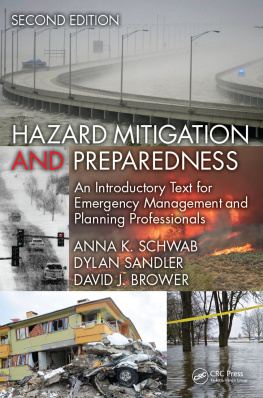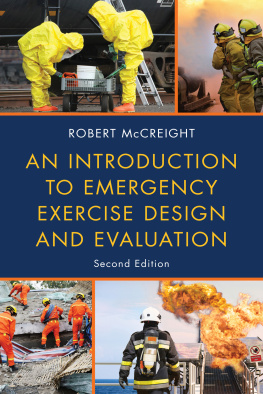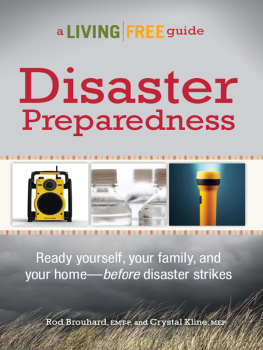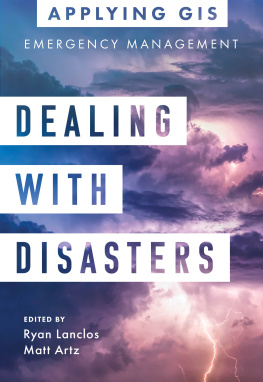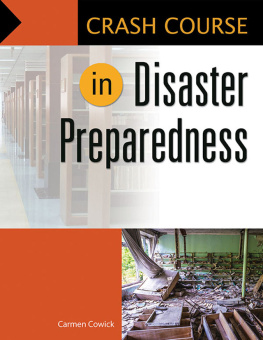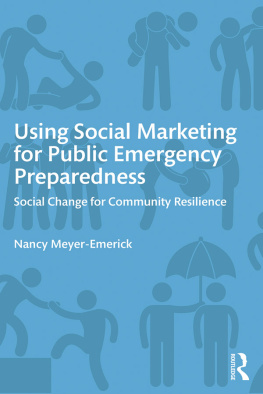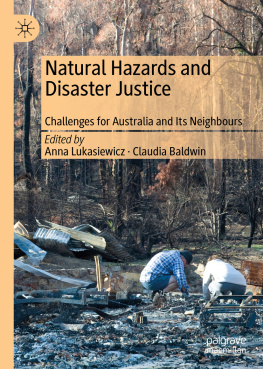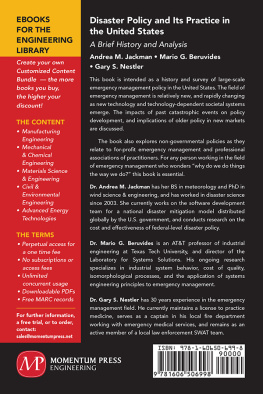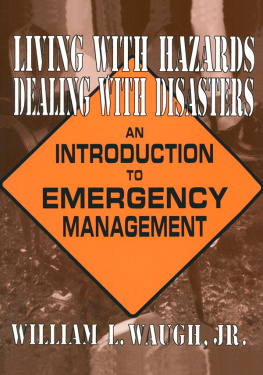Contents
Page List
Guide

SECOND EDITION
HAZARD MITIGATION AND PREPAREDNESS
An Introductory Text for Emergency Management and Planning Professionals
SECOND EDITION
HAZARD MITIGATION AND PREPAREDNESS
An Introductory Text for Emergency Management and Planning Professionals
ANNA K. SCHWAB
DYLAN SANDLER
DAVID J. BROWER

CRC Press
Taylor & Francis Group
6000 Broken Sound Parkway NW, Suite 300
Boca Raton, FL 33487-2742
2017 by Taylor & Francis Group, LLC
CRC Press is an imprint of Taylor & Francis Group, an Informa business
No claim to original U.S. Government works
Printed on acid-free paper
Version Date: 20160224
International Standard Book Number-13: 978-1-4665-9556-9 (Hardback)
This book contains information obtained from authentic and highly regarded sources. Reasonable efforts have been made to publish reliable data and information, but the author and publisher cannot assume responsibility for the validity of all materials or the consequences of their use. The authors and publishers have attempted to trace the copyright holders of all material reproduced in this publication and apologize to copyright holders if permission to publish in this form has not been obtained. If any copyright material has not been acknowledged please write and let us know so we may rectify in any future reprint.
Except as permitted under U.S. Copyright Law, no part of this book may be reprinted, reproduced, transmitted, or utilized in any form by any electronic, mechanical, or other means, now known or hereafter invented, including photocopying, microfilming, and recording, or in any information storage or retrieval system, without written permission from the publishers.
For permission to photocopy or use material electronically from this work, please access www.copyright.com (http://www.copyright.com/) or contact the Copyright Clearance Center, Inc. (CCC), 222 Rosewood Drive, Danvers, MA 01923, 978-750-8400. CCC is a not-for-profit organization that provides licenses and registration for a variety of users. For organizations that have been granted a photocopy license by the CCC, a separate system of payment has been arranged.
Trademark Notice: Product or corporate names may be trademarks or registered trademarks, and are used only for identification and explanation without intent to infringe.
Library of Congress Cataloging-in-Publication Data
Names: Schwab, Anna K., author. | Sandler, Dylan, author. | Brower, David J., author.
Title: Hazard mitigation and preparedness : an introductory text for emergency management and planning professionals / Anna K. Schwab, Dylan Sandler, and David J. Brower.
Description: Second edition. | Boca Raton, FL : CRC Press, 2016. | Includes bibliographical references and index.
Identifiers: LCCN 2016001259 | ISBN 9781466595569 (alk. paper)
Subjects: LCSH: Emergency management--United States. | Hazard mitigation--United States. | Preparedness. | Community power--United States.
Classification: LCC HV551.3 .S39 2016 | DDC 363.34/70973--dc23
LC record available at http://lccn.loc.gov/2016001259
Visit the Taylor & Francis Web site at
http://www.taylorandfrancis.com
and the CRC Press Web site at
http://www.crcpress.com
Contents
Nearly a decade has passed since the first edition of Hazard Mitigation and Preparedness was published. During this time, there have been far-reaching changes in our understanding of and experience coping with natural hazards and climate change. During the same time period, disaster losses have continued to rise. In the United States, Hurricane Sandy has challenged us to more effectively protect highly urbanized areas from coastal storms and sea level rise, while infrastructure systems age and become increasingly brittle. Prolonged droughts in the American Southwest are pushing us to make difficult choices about how to conserve and distribute limited water supplies across competing agricultural, industrial, and residential needs. Some neighborhoods in Miami and South Florida are experiencing daily, high-tide flooding as the water table rises. Natural hazards are by no means a new phenomenon, but the scientific consensus regarding climate change makes it clear that these extreme events are precursors of sobering challenges to come.
The same can be said of disasters in the international context. While the global community struggles to deal with increasingly violent religious and ethnic strife, deadly civil wars, and vast numbers of refugees fleeing their native lands, it is apparent that the catalyst for many of these tragedies may be linked to extreme natural hazards resulting from climate change. One such instance has been documented in a study published by the National Academy of Sciences, which linked an extensive drought in Syria that occurred between 2006 and 2009 with climate change, finding the disaster was a contributing factor to the violent uprisings that began in that country in 2011. The 2015 Nepal earthquake that killed more than 8800 people and displaced nearly half a million more was another stark reminder that disastrous events in very poor and politically paralyzed nations tend to result in greater loss of life and exacerbate other social, economic, and environmental problems.
To address these growing risks, a number of initiatives have gained traction in recent years. The United States is limiting carbon pollution from power plants and cars and has proposed rules to address methane pollution. The National Flood Insurance Program was amended twice in 3 years as the nation grapples with the need to provide economic protections for communities and individuals in the floodplain while also promoting responsible and safe development. Philanthropies are showing particular interest in programs that support greater disaster resilience, exemplified by the Rockefeller Foundation investment of more than $100 million in the 100 Resilient Cities Challenge to support cities as they plan for the future.
Powerful conversations are also occurring in the private sector about the role of business and industry in creating an environment that is both good for commerce and good for people. In 2015, Europes six largest oil and gas companies called on governments to introduce a price for carbon emissions and are pressuring major U.S. oil companies to join this appeal. Businesses are taking steps, large and small, to make their own operations more resilientincorporating redundancy in supply chains and investing in facilities and equipment that are threatened by increased heat, stronger storms, more frequent wildfires, or rising seas.
In December 2015, the world came together in unprecedented ways as 196 countries participated in the United Nations Climate Conference. The resulting Paris Agreement, which is intended to become legally binding, sets a goal that limits global warming and provides a financing mechanism to support less wealthy countries adapt to adverse impacts. While there are ongoing challenges to implementation and enforcement of the Agreement, it is undoubtedly an important step at the international level to confront the causes and effects of climate change worldwide.
However, in the midst of all this progress, much remains the same in the way that we plan for disasters at the local level. There is no magic bullet or technological fix that will make natural and human-made hazards disappear. Rather, it falls on individualsemergency managers, city planners, building inspectors, resource managers, business owners, and homeownersto anticipate risks and take steps to reduce them. It falls on neighborhoods, small towns, and large cities to learn about the potential hazards they face and plan for a safer, healthier future. For that reason, while the second edition of

